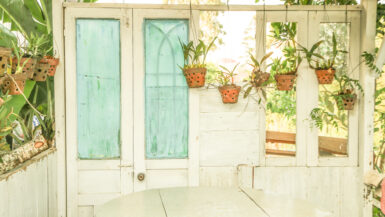Indoor vertical gardening has emerged as an innovative and practical solution for individuals seeking to cultivate their green thumb in the limited confines of their living spaces. This gardening method offers seniors a unique and accessible opportunity to engage in a fulfilling and therapeutic hobby.
This comprehensive guide will delve into the core aspects of indoor vertical gardening for seniors. We discuss the various benefits, suitable plants, and essential tools required to successfully establish and maintain a thriving green sanctuary within the comforts of one’s home.
Join us as we explore the world of vertical gardening, explicitly tailored to the needs and preferences of seniors, and embark on a rewarding journey towards greener, healthier, and more sustainable living.
Benefits of Vertical Gardening for Seniors
Indoor vertical gardening is an increasingly popular hobby that offers numerous advantages to seniors. From improving physical and mental well-being to maximizing limited space, this gardening technique provides an array of benefits tailored to the needs and preferences of senior individuals. In this section, we will explore some of the most noteworthy benefits that vertical gardening can bring to the lives of seniors.
1. Space-Saving Solution
Vertical gardening is particularly advantageous for seniors who live in smaller apartments or homes with limited outdoor space. Growing plants vertically allows seniors to create a lush, green oasis without sacrificing valuable floor space. This allows for cultivating various plants, even in the most compact living environments.
2. Enhanced Accessibility
Gardening can be physically demanding, particularly for seniors struggling with mobility or joint issues. Vertical gardening solves this problem by eliminating the need to bend or crouch while tending to plants. By positioning the plants at the waist or eye level, seniors can comfortably care for their garden without putting unnecessary strain on their bodies.
3. Improved Air Quality
Indoor plants act as natural air purifiers, removing harmful pollutants and toxins from the air. This is particularly beneficial for seniors who may be more susceptible to respiratory issues. With their increased plant density, vertical gardens can significantly improve indoor air quality, creating a healthier living environment for seniors.
4. Therapeutic Benefits
Gardening has long been recognized as a therapeutic activity, offering physical, mental, and emotional benefits. For seniors, engaging in indoor vertical gardening can help reduce stress, promote relaxation, and provide a sense of accomplishment. Additionally, tending to a garden can stimulate cognitive function and improve concentration, which is particularly valuable for seniors seeking to maintain mental acuity.
5. Aesthetic Appeal
Indoor vertical gardens can transform a living space into a vibrant, visually appealing environment. Seniors can take pride in showcasing their creative talents by carefully selecting plants and arranging them in eye-catching patterns. By incorporating various elements from our guide on Ways to Enhance Your Indoor Vertical Garden with Aesthetic Appeal, seniors can create a stunning indoor garden that is an attractive focal point in their home.
Overall, indoor vertical gardening offers many benefits specifically tailored to the needs of seniors. By embracing this innovative gardening technique, seniors can enjoy a rewarding hobby that improves their quality of life and adds a touch of greenery and beauty to their living spaces.
Easy-to-Assemble Vertical Garden Systems
This section will explore various easy-to-assemble vertical garden systems perfect for seniors looking to start their journey into indoor vertical gardening. These systems are designed to be user-friendly, space-saving, and visually appealing. They are ideal for seniors who wish to cultivate a thriving indoor garden without complicated installations or extensive maintenance.
1. Modular Wall Planters
Modular wall planters are an excellent choice for seniors, as they are easy to install, and their customizable design allows for personalized garden arrangements. These planters consist of separate containers attached to a wall or a compatible frame. With various materials and designs, modular wall planters offer versatility and style, enabling seniors to create a unique indoor garden tailored to their preferences.
2. Vertical Garden Pockets
Vertical garden pockets are another simple yet effective option for indoor vertical gardening. Made from durable, breathable materials, these pockets can be hung on walls or other vertical surfaces, providing ample room for plants to grow. Their lightweight design makes them easy to handle and rearrange, allowing seniors to curate their garden layout effortlessly without needing heavy lifting or complex assembly.
3. Freestanding Vertical Garden Planters
Freestanding vertical garden planters offer a portable and low-maintenance option for seniors who prefer not to install permanent fixtures in their living spaces. These self-contained units often feature built-in irrigation systems, ensuring plants receive the necessary water and nutrients with minimal effort.
Selecting a freestanding planter with easy-to-reach shelves or compartments allows seniors to comfortably tend to their gardens without bending or stretching.
4. Hanging Baskets and Planters
Hanging baskets and planters are a classic option for vertical gardening, providing a visually appealing and space-saving solution for seniors. In various materials and styles, hanging planters can be suspended from ceiling hooks or wall brackets, creating a cascading garden effect. Seniors should opt for lightweight materials and easy-to-maintain plants to ensure effortless upkeep and minimal strain on their indoor garden.
5. Repurposed Household Items
Repurposed household items can serve as unique and cost-effective vertical garden systems for seniors who enjoy creativity and resourcefulness. Old shoe organizers, ladders, or shelving units can be transformed into functional and attractive vertical gardens with imagination and some basic DIY skills. Not only does this approach allow seniors to express their creativity, but it also promotes sustainable and eco-friendly gardening practices.
By exploring these easy-to-assemble vertical garden systems, seniors can successfully cultivate their indoor oasis without extensive gardening knowledge or experience. Focusing on accessibility, convenience, and aesthetic appeal, these systems provide seniors with the necessary tools to create and maintain a flourishing indoor vertical garden that enhances their living space and overall well-being.
Choosing the Right Plants for Indoor Gardens
Selecting the appropriate plants for an indoor vertical garden ensures the garden thrives and provides the desired aesthetic and health benefits. In this subsection, we will delve into the key factors to consider when choosing plants for an indoor vertical garden. We will also discuss some popular options that are easy to grow and visually appealing.
Factors to Consider When Selecting Plants
Before diving into the vast array of plants available for indoor gardening, it is essential to consider a few factors that will influence the success and maintenance of your indoor vertical garden:
1. Light Requirements: Assess the amount of natural light your indoor space receives and choose plants best suited to that condition. Some plants thrive in low light, while others require bright, indirect sunlight to grow.
2. Space Constraints: Vertical gardens are designed to maximize space, but it is still essential to consider your chosen plants’ size and growth habits. Opt for plants with compact growth or those that can be easily pruned to maintain a manageable size.
3. Maintenance Needs: Seniors may prefer plants with low maintenance requirements to reduce the physical strain and time-consuming tasks associated with garden upkeep. Choose plants that are easy to care for, drought-tolerant, and resistant to common pests and diseases.
4. Aesthetic Preferences: The visual appeal of your indoor vertical garden is equally important. Consider plants with varying textures, colors, and foliage patterns to create an eye-catching arrangement that complements your living space.
Popular and Easy-to-Grow Indoor Plants
Here are some popular indoor plant options that are both visually appealing and easy to grow, making them ideal choices for an indoor vertical garden:
1. Pothos (Epipremnum aureum): Pothos is a hardy, low-maintenance plant that thrives in light conditions. Its trailing vines add a cascading effect to vertical gardens, and its variegated leaves provide an interesting visual texture.
2. Snake Plant (Sansevieria trifasciata): Known for its architectural, upright leaves, the snake plant is visually striking, highly adaptable to various light conditions, and requires minimal watering.
3. Spider Plant (Chlorophytum comosum): The spider plant is an excellent choice for hanging baskets or planters in vertical gardens. Its arching leaves and small, white flowers create an attractive display, while its ability to thrive in light conditions makes it easy to grow.
4. English Ivy (Hedera helix): This classic vine is known for its trailing growth habit and attractive lobed leaves. It thrives in bright, indirect light and can be easily pruned to maintain its size and shape.
5. Peace Lily (Spathiphyllum spp.): With its elegant, dark green leaves and showy white flowers, the peace lily adds a touch of sophistication to any indoor vertical garden. It prefers low to medium light and requires minimal watering.
By carefully considering the factors discussed above and selecting appropriate plants, seniors can create a thriving and visually appealing indoor vertical garden that is both easy to maintain and a joy to behold. With the right plant choices, an indoor vertical garden can become an accessible and fulfilling hobby that enhances seniors’ well-being and adds a touch of greenery to their living spaces.
Tips for Successful Indoor Vertical Gardening
Embarking on the indoor vertical gardening journey can be exciting and challenging, especially for seniors who may be new to this innovative gardening method. Adopting specific strategies and best practices tailored to indoor vertical gardening is crucial to ensure a thriving and rewarding experience.
This section will explore tips on how to help seniors create a successful and sustainable indoor vertical garden, from proper plant care to effective pest management.
1. Optimize Your Growing Conditions
To achieve a flourishing indoor vertical garden, it is essential to create an environment that closely mimics the natural growing conditions of your selected plants. This includes providing the appropriate light, water, and humidity and maintaining a consistent temperature. For example, investing in a grow light or a humidifier can help seniors maintain the ideal conditions for their plants to thrive.
2. Pay Attention to Plant Compatibility
You must ensure the plants’ compatibility when designing an indoor vertical garden. Select plants with similar light, water, and nutrient requirements to make it easier to provide consistent care. Additionally, avoid combining plants with aggressive growth habits that may overshadow or outcompete their neighbors, ensuring each plant has the opportunity to grow and flourish.
3. Use Quality Soil and Fertilizer
Proper nutrition is key to the success of any garden, and indoor vertical gardens are no exception. Seniors should invest in high-quality potting soil and organic fertilizers tailored to their plants’ needs. Regularly replenishing nutrients through appropriate feeding schedules will promote healthy growth and reduce the likelihood of plant stress or diseases.
4. Monitor and Manage Pests
Indoor gardens can still fall victim to common pests such as aphids, spider mites, and fungus gnats. Regularly inspect your plants for signs of infestations and promptly address any issues to prevent the spread of pests. Utilize organic and non-toxic pest control methods, such as neem oil or insecticidal soap, to protect your plants without exposing yourself or your environment to harmful chemicals.
5. Practice Proper Pruning and Maintenance
Regular pruning and maintenance are essential for a visually appealing and healthy indoor vertical garden. Seniors should remove dead or yellowing leaves, trim back excessive growth, and adequately support plants. This improves the garden’s aesthetic appeal, promotes better air circulation, and reduces the risk of diseases.
6. Be Patient and Adapt
Gardening generally requires patience and the willingness to learn from experience. Seniors should not be discouraged by initial setbacks or challenges; instead, they should view them as opportunities to refine their gardening skills and adapt their approach. By closely observing plant growth, seniors can better understand their indoor garden’s unique needs and adjust accordingly to ensure long-term success.
By implementing these tips and best practices, seniors can maximize their chances of cultivating a thriving, beautiful, and rewarding indoor vertical garden. With patience, dedication, and a commitment to proper plant care, seniors can enjoy the many benefits of indoor vertical gardening and transform their living space into a lush, green oasis that enhances their overall well-being.
Therapeutic Effects of Gardening on Senior Health
Indoor vertical gardening offers seniors a unique and rewarding experience. It provides many therapeutic benefits that significantly improve their health and well-being. This subsection will explore how gardening can positively impact senior health, from enhancing physical fitness to promoting emotional stability and cognitive function.
By understanding the therapeutic effects of gardening, seniors can fully embrace this fulfilling hobby and experience a profound improvement in their quality of life.
Boosting Physical Fitness and Mobility
Gardening is a low-impact form of exercise that aids in maintaining and improving physical fitness for seniors. Tending to an indoor vertical garden involves various activities, such as watering, pruning, and repotting, which can help maintain muscle strength, flexibility, and balance.
Moreover, vertical gardens eliminate the need for bending or crouching, making gardening more accessible and less strenuous for seniors with mobility limitations.
Reducing Stress and Anxiety
Gardening has long been recognized for its stress-relieving properties. Engaging in indoor vertical gardening can help seniors focus on nurturing and caring for their plants, diverting their minds from negative thoughts or daily stressors. The calming effects of being surrounded by greenery can significantly reduce anxiety levels and promote a sense of relaxation and tranquility.
Enhancing Emotional Well-Being
Cultivating a thriving indoor garden can give seniors a sense of accomplishment, pride, and purpose. Successfully nurturing plants from seeds or cuttings to full-grown, thriving specimens can instill a feeling of achievement and self-efficacy. This, in turn, can improve seniors’ overall emotional well-being and contribute to a more positive outlook on life.
Stimulating Cognitive Function
Gardening is an engaging and mentally stimulating activity that can help maintain and improve cognitive function in seniors. Planning, organizing, and caring for an indoor vertical garden requires focus, problem-solving, and decision-making skills. Learning about plants, their growth habits, and their care requirements can keep the mind active and sharp, potentially delaying the onset of age-related cognitive decline.
Promoting Social Interaction
Gardening can serve as a platform for social interaction, allowing seniors to connect with like-minded individuals, share their gardening experiences, and learn from others. Participating in gardening clubs or online forums can help seniors build a sense of community and belonging, reducing feelings of loneliness and isolation often experienced in older age.
Fostering Creativity and Self-Expression
Designing and maintaining an indoor vertical garden allows seniors to express their creativity and aesthetic preferences. By carefully selecting plants, arranging them in visually appealing patterns, and experimenting with various container styles, seniors can create a personalized space that reflects their unique tastes and sensibilities. This creative outlet can significantly contribute to seniors’ happiness and life satisfaction.
The therapeutic effects of gardening on senior health are undeniable. It offers many physical, mental, and emotional benefits that significantly improve their well-being. By embracing indoor vertical gardening as a hobby, seniors can experience the transformative power of nature and cultivate a healthier, more fulfilling lifestyle.







Leave a reply